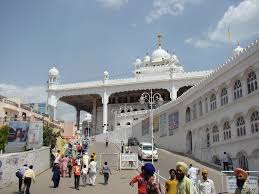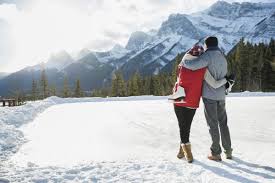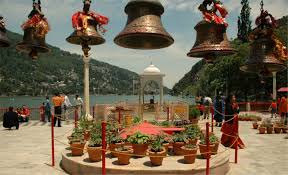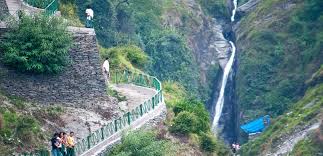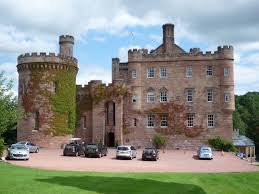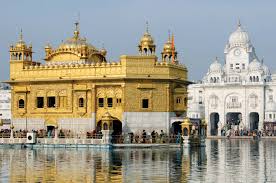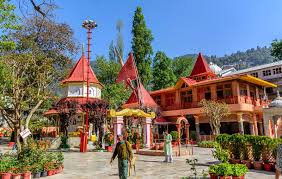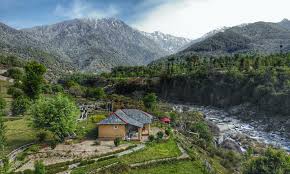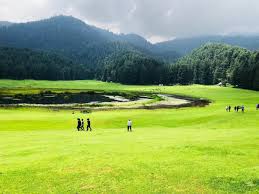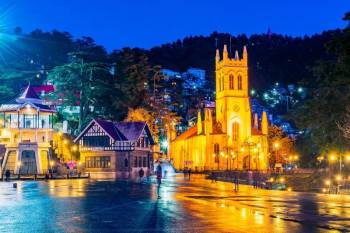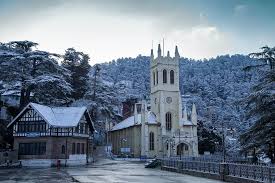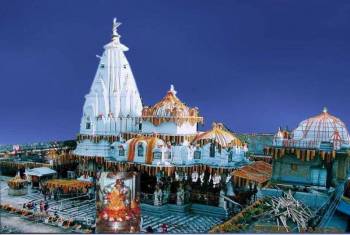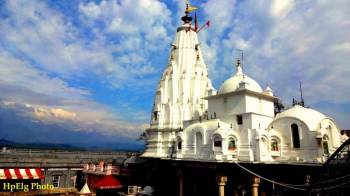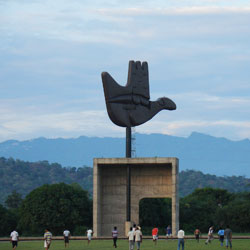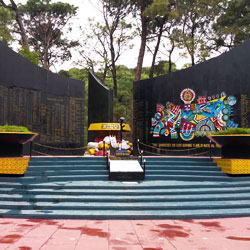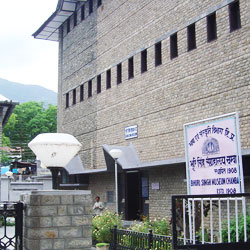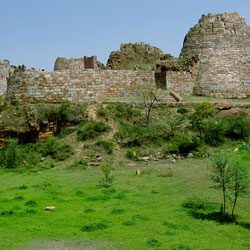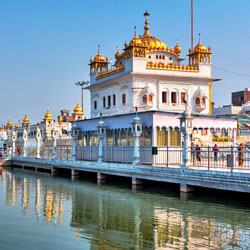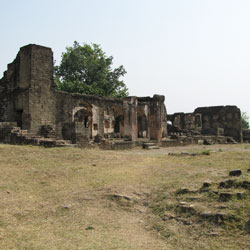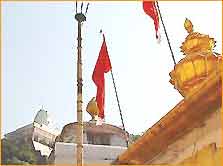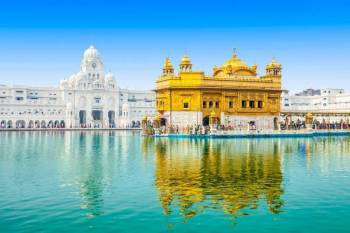Pathankot Dalhousie Dharamshala Naina Devi Anandpur sahib Tour
Duration : 5 Nights / 6 Days
Destination Covered : Pathankot, Dalhousie, Dharamshala, Chintpurni, Chandigarh City
Tour Activities : Hill Stations & Valleys, Religious & Pilgrimage
Price on Request
Pathankot, Dalhousie and Dharamshala Tour Itinerary
Day 1
Arrive At Pathankot Railway Station and Drive to (2-3Hrs.) Dalhousie. Night stay at Dalhousie hotel.
MEAL PLAN— DINNER(VEG.)
MEAL PLAN— DINNER(VEG.)
Day 2
Early morning after breakfast drive to Khajjiar, one of the most scenic saucer shaped Plateau and is surrounded by dense pine and deodar forests, its beauty has further been enhanced by a small lake in the center with a floating island and 9-hole golf course here are the other interesting places to cover are St.Josheph Church,Daind Kund,Kala Top(wildlife sanctuary depends upon you if you want to go by hiring local vehicle at your own cost),
Panchkula(adventure point).In evening ,vist to local market(mall
road). Return to Dalhousie Hotel. Night stay in Dalhousie.
MEAL PLAN— BREAKFAST AND DINNER .
Panchkula(adventure point).In evening ,vist to local market(mall
road). Return to Dalhousie Hotel. Night stay in Dalhousie.
MEAL PLAN— BREAKFAST AND DINNER .
Day 3
Check Out After Breakfast and Drive to Dharamshala. On the way
we will cover Sunset Point. Night stay in the hotel at Dharamshala.
MEAL PLAN—BREAKFAST AND DINNER
we will cover Sunset Point. Night stay in the hotel at Dharamshala.
MEAL PLAN—BREAKFAST AND DINNER
Day 4
After Breakfast, Take a Drive and Spend Time Exploring the
Colourful Pockets of Mcleodganj. Visit the Famous Home of the
Dalai Lama – the Dalai Lama Temple, the Bhagsu Nag Temple and
the Bhagsu Waterfall, the Orange and Beautiful Naddi Sunset Point,
the Ancient St. John Church, the Dal Lake, Cricket Stadium and War
memorial. Night stay at hotel.
MEAL PLAN—BREAKFAST AND DINNER
Colourful Pockets of Mcleodganj. Visit the Famous Home of the
Dalai Lama – the Dalai Lama Temple, the Bhagsu Nag Temple and
the Bhagsu Waterfall, the Orange and Beautiful Naddi Sunset Point,
the Ancient St. John Church, the Dal Lake, Cricket Stadium and War
memorial. Night stay at hotel.
MEAL PLAN—BREAKFAST AND DINNER
Day 5
On this day we will cover the following Temples—
1. Chamunda Temple— Chamunda (Sanskrit: चामुण्डा, IAST:
Cā muṇḍā ) also known as Chamundeshwari, Charchika and
Rakta Kali is a fearsome form of Chandi , the Hindu Divine
Mother Durga and one of the seven Matrikas (mother
goddesses).[2] She is also one of the chief Yoginis, a group of
sixty-four or eighty-one Tantric goddesses, who are attendants
of the warrior goddess Durga.[3] The name is a combination of
Chanda and Munda, two monsters whom Chamunda killed. She
is closely associated with Kali, another fierce aspect of
Parvati. She is identified with goddesses Parvati, Chandi or
Durga as well. The goddess is often portrayed as haunting
cremation grounds or fig trees. The goddess is worshipped by
ritual animal sacrifices along with offerings of wine and in the
ancient times, human sacrifices were offered too. Originally a
tribal goddess, Chamunda was given animal sacrifices but
with Shaivite and Vaishnavite influences, the practice has
become less.
2. Brijeshwari Temple— The Shree Vajreshwari Mata Mandir also
known as Kangra Devi Mandir is a Hindu temple dedicated to
the goddess Vajreshvari, a form of Durga located in the town
Kangra, in Himachal Pradesh, India. The main gate entrance
has a Nagarkhana or drum house and is built similar to the
Bassein fort entrance. The temple is also surrounded by a
stone wall like a fort. Inside the main area Goddess
Vajreshvari is present in the form of Pindi. The temple also
have a small temple of Bhairav. In front of the main temple an
idol of Dhayanu Bhagat is also present. He had offered his
head to the Goddess at the time of Akbar. The present
structure has three tombs in it, which is unique in itself.
3. Jawali Ji Temple— Jwala Ji (Pahari: जवाला जी, Punjabi: ਜਵਾਲਾ ਜੀ,
Hindi: ज्वाला जी, Urdu: جوالا جی ) is a Hindu Goddess. Alternative
spelling and names for Jwala Ji include Jawala Ji, Jwala Devi
and Jwalamukhi Ji. The physical manifestation of Jwala Ji is
always a set of eternal flames,[2] and the term Jwala means
flame in Sanskrit (cognates: proto-Indo-European guelh,
English: glow, Lithuanian: zvilti)[3] and Ji is an honorific used in
the Indian subcontinent. Jwalaji/jawalaji (flame) or Jwala
Mukhi (flame mouth) is probably the most ancient temple
discussed here besides Vaishno Devi. It is mentioned in the
Mahabharata and other scriptures. There is a natural cave
where eternal flames continue to burn. Some say there are
nine flames for the nine Durgas ... Several schools of Buddhism
also share the symbolism of a seven-forked sacred flame.
4. Chintpurni Temple— Chintpurni is a major pilgrimage Centre
and one of the Shakti Peethas in India. The Chintpurni shakti
peeth (Chhinnamastika shakti peeth) is located in Una district
Himachal Pradesh state, surrounded by the western Himalaya
in the north and east in the smaller Shiwalik (or Shivalik) range
bordering the state of Punjab.[1] The Chintpurni Shakti Peeth
houses the temple of Chinnamastika Devi or Chinnamasta
Devi. Chhinnamasta or Chinnamastika temple is one of the 7
major and 51 total Shakti Peethas.[2] Here, Chhinnamasta is
interpreted as the severed-headed one as well as the
foreheaded-one.[3] The Hindu genealogy registers at Chintpurni,
Himachal Pradesh are kept here. One cannot take the prasad
offered to deity along with them.
Night stay will be at Chintpurni Hotel.
MEAL PLAN—BREAKFAST AND DINNER
1. Chamunda Temple— Chamunda (Sanskrit: चामुण्डा, IAST:
Cā muṇḍā ) also known as Chamundeshwari, Charchika and
Rakta Kali is a fearsome form of Chandi , the Hindu Divine
Mother Durga and one of the seven Matrikas (mother
goddesses).[2] She is also one of the chief Yoginis, a group of
sixty-four or eighty-one Tantric goddesses, who are attendants
of the warrior goddess Durga.[3] The name is a combination of
Chanda and Munda, two monsters whom Chamunda killed. She
is closely associated with Kali, another fierce aspect of
Parvati. She is identified with goddesses Parvati, Chandi or
Durga as well. The goddess is often portrayed as haunting
cremation grounds or fig trees. The goddess is worshipped by
ritual animal sacrifices along with offerings of wine and in the
ancient times, human sacrifices were offered too. Originally a
tribal goddess, Chamunda was given animal sacrifices but
with Shaivite and Vaishnavite influences, the practice has
become less.
2. Brijeshwari Temple— The Shree Vajreshwari Mata Mandir also
known as Kangra Devi Mandir is a Hindu temple dedicated to
the goddess Vajreshvari, a form of Durga located in the town
Kangra, in Himachal Pradesh, India. The main gate entrance
has a Nagarkhana or drum house and is built similar to the
Bassein fort entrance. The temple is also surrounded by a
stone wall like a fort. Inside the main area Goddess
Vajreshvari is present in the form of Pindi. The temple also
have a small temple of Bhairav. In front of the main temple an
idol of Dhayanu Bhagat is also present. He had offered his
head to the Goddess at the time of Akbar. The present
structure has three tombs in it, which is unique in itself.
3. Jawali Ji Temple— Jwala Ji (Pahari: जवाला जी, Punjabi: ਜਵਾਲਾ ਜੀ,
Hindi: ज्वाला जी, Urdu: جوالا جی ) is a Hindu Goddess. Alternative
spelling and names for Jwala Ji include Jawala Ji, Jwala Devi
and Jwalamukhi Ji. The physical manifestation of Jwala Ji is
always a set of eternal flames,[2] and the term Jwala means
flame in Sanskrit (cognates: proto-Indo-European guelh,
English: glow, Lithuanian: zvilti)[3] and Ji is an honorific used in
the Indian subcontinent. Jwalaji/jawalaji (flame) or Jwala
Mukhi (flame mouth) is probably the most ancient temple
discussed here besides Vaishno Devi. It is mentioned in the
Mahabharata and other scriptures. There is a natural cave
where eternal flames continue to burn. Some say there are
nine flames for the nine Durgas ... Several schools of Buddhism
also share the symbolism of a seven-forked sacred flame.
4. Chintpurni Temple— Chintpurni is a major pilgrimage Centre
and one of the Shakti Peethas in India. The Chintpurni shakti
peeth (Chhinnamastika shakti peeth) is located in Una district
Himachal Pradesh state, surrounded by the western Himalaya
in the north and east in the smaller Shiwalik (or Shivalik) range
bordering the state of Punjab.[1] The Chintpurni Shakti Peeth
houses the temple of Chinnamastika Devi or Chinnamasta
Devi. Chhinnamasta or Chinnamastika temple is one of the 7
major and 51 total Shakti Peethas.[2] Here, Chhinnamasta is
interpreted as the severed-headed one as well as the
foreheaded-one.[3] The Hindu genealogy registers at Chintpurni,
Himachal Pradesh are kept here. One cannot take the prasad
offered to deity along with them.
Night stay will be at Chintpurni Hotel.
MEAL PLAN—BREAKFAST AND DINNER
Day 6
On this day we will cover the following destinations—
1. Bhakra Dam— Bhakra Dam is a concrete gravity dam on the
Sutlej River in Bilaspur, Himachal Pradesh in northern India.
The dam forms the Gobind Sagar reservoir. The dam, located
at a gorge near the (now submerged) upstream Bhakra village
in Bilaspur district of Himachal Pradesh of height 226 m.[1] The
length of the dam (measured from the road above it) is
518.25 m and the width is 9.1 m. Its reservoir known as
"Gobind Sagar" stores up to 9.34 billion cubic metres of water.
The 90 km long reservoir created by the Bhakra Dam is spread
over an area of 168.35 km2. In terms of quantity of water, it is
the third largest reservoir in India, the first being Indira Sagar
dam in Madhya Pradesh with capacity of 12.22 billion cu m and
second Nagarjunasagar Dam. Described as "New Temple of
Resurgent India" by Jawaharlal Nehru,[2] the first prime
minister of India, the dam attracts tourists from all over India.
Bhakra dam is 15 km from Nangal city and 20 km from Naina
Devi town.
2. Naina Devi— Mata Naina Devi is a town and a municipal
council in Bilaspur district in the Indian state of Himachal
Pradesh. The Temple of Shri Naina Devi Ji is situated on a
hilltop, base of which also has samadhi of bhagat Jatt Jeona
Morh, in the Bilaspur District, Himachal Pradesh, India. The
temple is connected with National Highway No. 21. The temple
at the top of the hill can be reached via road (that curves
round the hill up to a certain point) and then by concrete steps
(that finally reach the top). There is also a cable car facility
that moves pilgrims from the base of the hill all the way to the
top.
3. Anadpur Sahib Gurudwara Takht Sri Kesgarh Sahib— It is the
principal Sikh temple in the town. It marks the birthplace of
Khalsa and one of the five religious authorities (Five Takhts) of
Sikhism. Standing on a hillock, the present complex was built
between 1936 and 1944. The plan of the building is a square
set inside a 30 square metres (320 sq ft) square courtyard. In
it are the Takht's office and a Gurdwara. The Gurdwara has a
16 square metres (170 sq ft) square hall, inside which is 5.5
square metres (59 sq ft) square sanctum with the Sikh
scripture and old weapons used by Guru Gobind Singh's
Khalsa, signifying the miri and piri aspects of the Sikh faith.
The dome of the Gurdwara is fluted lotus. The lower levels of
the complex has a langar (free community kitchen run by
volunteers), a 55 square metres (590 sq ft) square divan hall,
and a row of rooms for pilgrims called the Dashmesh Nivas.
Nearby is an 80 square metres (860 sq ft) square sarovar (holy
water tank) for pilgrims to take their pilgrimage dip.
4. Virasat-e-Khalsa is a museum of Sikhism, located in the holy town,
Anandpur Sahib, near Chandigarh, the capital of the state of Punjab,
India. The museum celebrates 500 years of the Sikh history and the
300th anniversary of the birth of Khalsa, based on the scriptures
written by the tenth and last human guru, Guru Gobind Singh Ji. It
serves to attract tourists and pilgrims. This results in a consultation
between religion and emerging need in the building environment.
One side it promotes hand crafts to locals as well as nurturing a
sense of heritage, besides it recalls to infinity by the volumetric
interference of existing skyline is another phase of a visible
Urbanism dilemma.
After covering these areas we will drop you Chandigarh
Airport/Railway station.
MEAL PLAN—BREAKFAST
1. Bhakra Dam— Bhakra Dam is a concrete gravity dam on the
Sutlej River in Bilaspur, Himachal Pradesh in northern India.
The dam forms the Gobind Sagar reservoir. The dam, located
at a gorge near the (now submerged) upstream Bhakra village
in Bilaspur district of Himachal Pradesh of height 226 m.[1] The
length of the dam (measured from the road above it) is
518.25 m and the width is 9.1 m. Its reservoir known as
"Gobind Sagar" stores up to 9.34 billion cubic metres of water.
The 90 km long reservoir created by the Bhakra Dam is spread
over an area of 168.35 km2. In terms of quantity of water, it is
the third largest reservoir in India, the first being Indira Sagar
dam in Madhya Pradesh with capacity of 12.22 billion cu m and
second Nagarjunasagar Dam. Described as "New Temple of
Resurgent India" by Jawaharlal Nehru,[2] the first prime
minister of India, the dam attracts tourists from all over India.
Bhakra dam is 15 km from Nangal city and 20 km from Naina
Devi town.
2. Naina Devi— Mata Naina Devi is a town and a municipal
council in Bilaspur district in the Indian state of Himachal
Pradesh. The Temple of Shri Naina Devi Ji is situated on a
hilltop, base of which also has samadhi of bhagat Jatt Jeona
Morh, in the Bilaspur District, Himachal Pradesh, India. The
temple is connected with National Highway No. 21. The temple
at the top of the hill can be reached via road (that curves
round the hill up to a certain point) and then by concrete steps
(that finally reach the top). There is also a cable car facility
that moves pilgrims from the base of the hill all the way to the
top.
3. Anadpur Sahib Gurudwara Takht Sri Kesgarh Sahib— It is the
principal Sikh temple in the town. It marks the birthplace of
Khalsa and one of the five religious authorities (Five Takhts) of
Sikhism. Standing on a hillock, the present complex was built
between 1936 and 1944. The plan of the building is a square
set inside a 30 square metres (320 sq ft) square courtyard. In
it are the Takht's office and a Gurdwara. The Gurdwara has a
16 square metres (170 sq ft) square hall, inside which is 5.5
square metres (59 sq ft) square sanctum with the Sikh
scripture and old weapons used by Guru Gobind Singh's
Khalsa, signifying the miri and piri aspects of the Sikh faith.
The dome of the Gurdwara is fluted lotus. The lower levels of
the complex has a langar (free community kitchen run by
volunteers), a 55 square metres (590 sq ft) square divan hall,
and a row of rooms for pilgrims called the Dashmesh Nivas.
Nearby is an 80 square metres (860 sq ft) square sarovar (holy
water tank) for pilgrims to take their pilgrimage dip.
4. Virasat-e-Khalsa is a museum of Sikhism, located in the holy town,
Anandpur Sahib, near Chandigarh, the capital of the state of Punjab,
India. The museum celebrates 500 years of the Sikh history and the
300th anniversary of the birth of Khalsa, based on the scriptures
written by the tenth and last human guru, Guru Gobind Singh Ji. It
serves to attract tourists and pilgrims. This results in a consultation
between religion and emerging need in the building environment.
One side it promotes hand crafts to locals as well as nurturing a
sense of heritage, besides it recalls to infinity by the volumetric
interference of existing skyline is another phase of a visible
Urbanism dilemma.
After covering these areas we will drop you Chandigarh
Airport/Railway station.
MEAL PLAN—BREAKFAST
More Details about Pathankot, Dalhousie and Dharamshala Tour
Inclusions
- MAP (Room + Breakfast + Lunch/Dinner)
- Hotel
- Sightseeing
- Accommodation in 2,3 or above Star Hotels according to your
- budget.
- All sightseeing, transfers by Sudan cab(AC).
- Running hot and cold water in All Hotels
- All toll taxes, driver batta, fuel charges etc.
- Daily Morning Tea, Breakfast, Dinner (buffe veg) in hotels
- All Taxes
Exclusions
- All expenses of personalised nature like phone calls, laundry,
- cool drinks etc.,
- Lunch
- All Entrance Fees
- Anything not mentioned in the “Package cost Includes” .
Payments Terms
- Some Advance Percentage of total booking amount
- Airfare/Transport fare to be paid full at one time in advance.
Cancellation & Refund Policy
- Upon cancellation, refund will be made after deducting the Retention Amount.
- Retention Amount varies as per the number of days left before your package start date.
Packages by Theme
Fill Enquiry Form Below

